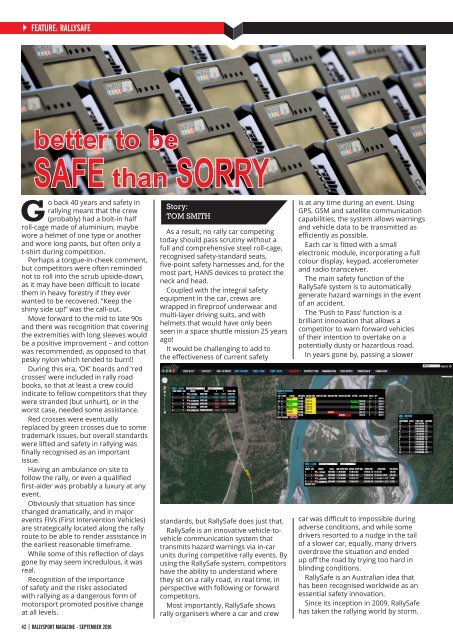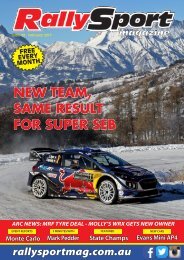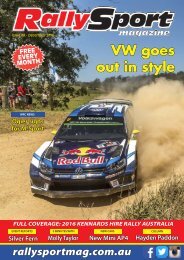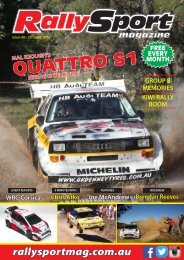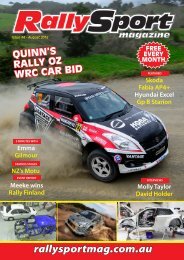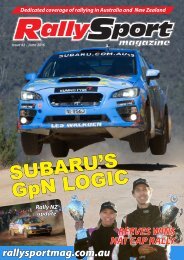RallySport Magazine September 2016
The September issue of RallySport Magazine features the latest rallying news form Australia and New Zealand, including coverage of the World Rally Championship.
The September issue of RallySport Magazine features the latest rallying news form Australia and New Zealand, including coverage of the World Rally Championship.
Create successful ePaper yourself
Turn your PDF publications into a flip-book with our unique Google optimized e-Paper software.
FEATURE: RALLYSAFE<br />
better to be<br />
SAFE than SORRY<br />
Go back 40 years and safety in<br />
rallying meant that the crew<br />
(probably) had a bolt-in half<br />
roll-cage made of aluminium, maybe<br />
wore a helmet of one type or another<br />
and wore long pants, but often only a<br />
t-shirt during competition.<br />
Perhaps a tongue-in-cheek comment,<br />
but competitors were often reminded<br />
not to roll into the scrub upside-down,<br />
as it may have been difficult to locate<br />
them in heavy forestry if they ever<br />
wanted to be recovered. “Keep the<br />
shiny side up!” was the call-out.<br />
Move forward to the mid to late 90s<br />
and there was recognition that covering<br />
the extremities with long sleeves would<br />
be a positive improvement – and cotton<br />
was recommended, as opposed to that<br />
pesky nylon which tended to burn!!<br />
During this era, ‘OK’ boards and ‘red<br />
crosses’ were included in rally road<br />
books, so that at least a crew could<br />
indicate to fellow competitors that they<br />
were stranded (but unhurt), or in the<br />
worst case, needed some assistance.<br />
Red crosses were eventually<br />
replaced by green crosses due to some<br />
trademark issues, but overall standards<br />
were lifted and safety in rallying was<br />
finally recognised as an important<br />
issue.<br />
Having an ambulance on site to<br />
follow the rally, or even a qualified<br />
first-aider was probably a luxury at any<br />
event.<br />
Obviously that situation has since<br />
changed dramatically, and in major<br />
events FIVs (First Intervention Vehicles)<br />
are strategically located along the rally<br />
route to be able to render assistance in<br />
the earliest reasonable timeframe.<br />
While some of this reflection of days<br />
gone by may seem incredulous, it was<br />
real.<br />
Recognition of the importance<br />
of safety and the risks associated<br />
with rallying as a dangerous form of<br />
motorsport promoted positive change<br />
at all levels.<br />
42 | RALLYSPORT MAGAZINE - SEPTEMBER <strong>2016</strong><br />
Story:<br />
TOM SMITH<br />
As a result, no rally car competing<br />
today should pass scrutiny without a<br />
full and comprehensive steel roll-cage,<br />
recognised safety-standard seats,<br />
five-point safety harnesses and, for the<br />
most part, HANS devices to protect the<br />
neck and head.<br />
Coupled with the integral safety<br />
equipment in the car, crews are<br />
wrapped in fireproof underwear and<br />
multi-layer driving suits, and with<br />
helmets that would have only been<br />
seen in a space shuttle mission 25 years<br />
ago!<br />
It would be challenging to add to<br />
the effectiveness of current safety<br />
standards, but RallySafe does just that.<br />
RallySafe is an innovative vehicle-tovehicle<br />
communication system that<br />
transmits hazard warnings via in-car<br />
units during competitive rally events. By<br />
using the RallySafe system, competitors<br />
have the ability to understand where<br />
they sit on a rally road, in real time, in<br />
perspective with following or forward<br />
competitors.<br />
Most importantly, RallySafe shows<br />
rally organisers where a car and crew<br />
is at any time during an event. Using<br />
GPS, GSM and satellite communication<br />
capabilities, the system allows warnings<br />
and vehicle data to be transmitted as<br />
efficiently as possible.<br />
Each car is fitted with a small<br />
electronic module, incorporating a full<br />
colour display, keypad, accelerometer<br />
and radio transceiver.<br />
The main safety function of the<br />
RallySafe system is to automatically<br />
generate hazard warnings in the event<br />
of an accident.<br />
The ‘Push to Pass’ function is a<br />
brilliant innovation that allows a<br />
competitor to warn forward vehicles<br />
of their intention to overtake on a<br />
potentially dusty or hazardous road.<br />
In years gone by, passing a slower<br />
car was difficult to impossible during<br />
adverse conditions, and while some<br />
drivers resorted to a nudge in the tail<br />
of a slower car, equally, many drivers<br />
overdrove the situation and ended<br />
up off the road by trying too hard in<br />
blinding conditions.<br />
RallySafe is an Australian idea that<br />
has been recognised worldwide as an<br />
essential safety innovation.<br />
Since its inception in 2009, RallySafe<br />
has taken the rallying world by storm.


